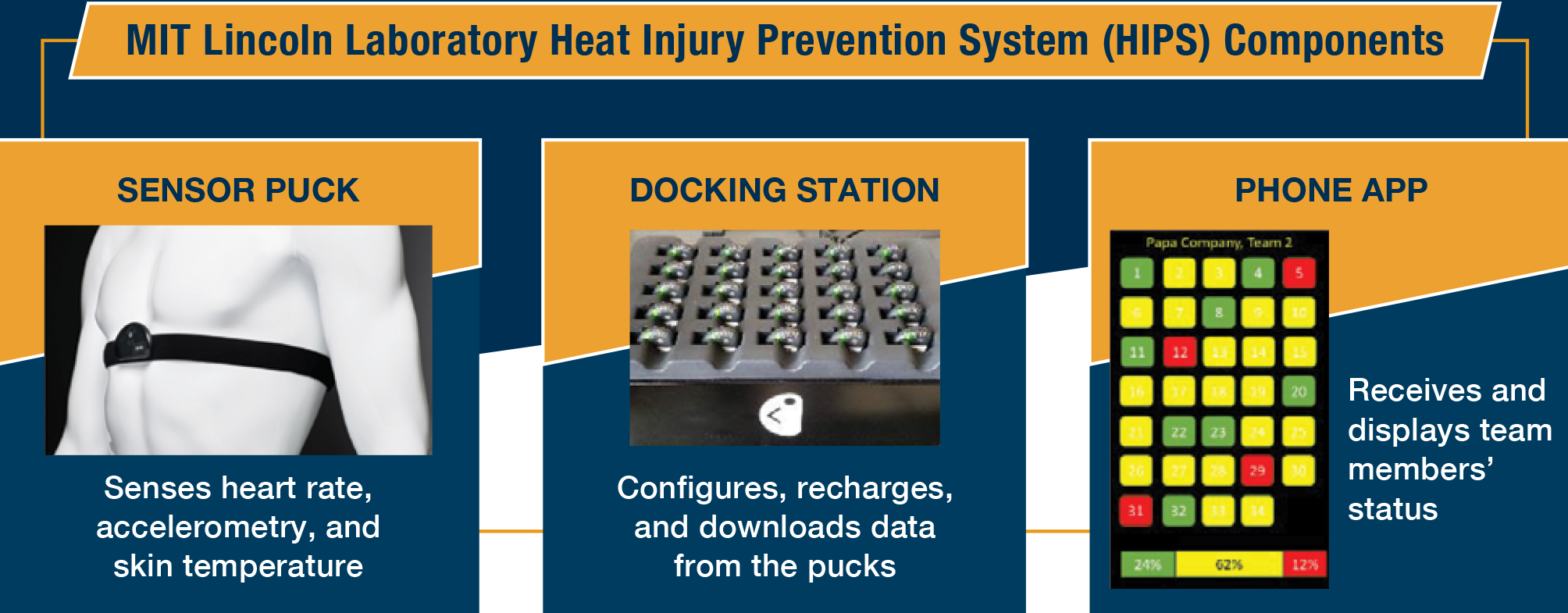Monitoring System for Preventing Heat Illness
Lincoln Laboratory has developed wearable technology that detects the physiological precursors of heat illness. This prototype system expands on previous technologies developed by the U.S. Army Research Institute of Environmental Medicine (USARIEM) for estimating heat strain. An enhanced version of the system will scale to large numbers of users, provide real-time data via wireless devices, and have extended battery life. A comfortable, affordable, and easy-to-use on-body system that warns of potential heat illness would help safeguard the health of servicemembers who rigorously train and exercise in intense heat.

From these sensors, the puck estimates core body temperature and adaptive physiological strain by using validated USARIEM-developed algorithms and a neuromotor incoordination index that reflects a decrease in coordination often observed with impending heat injuries. An early system prototype developed by MIT Lincoln Laboratory has been matured as a government product by Odic Inc.
Background
Heat-related illnesses, such as dehydration, heat exhaustion, and heat stroke that may escalate to death, are significant concerns to the military. The physical and cognitive effects of over-heating hamper a person’s ability to function effectively. For the military, which often trains and operates in hot environments, the problem is exemplified by recent numbers: in 2022, 415 instances of heat stroke and 1,912 cases of heat exhaustion were reported by the U.S. Military Health System. Many heat-related episodes are likely not reported if servicemembers “push through” the threat, recover quickly, or do not receive medical intervention.
Technology Response
USARIEM has developed technology to warn military personnel in training that they are approaching dangerous levels of heat exposure. These algorithms for assessing heat injury have been incorporated into a wearable prototype system. Lincoln Laboratory is applying its more than 20 years of research into physiological monitoring, the Army’s enabling technology, and a commercially available sensor to mature an on-body system that will
• Effectively monitor hundreds of users simultaneously
• Provide a wireless interface for users, including the capability for one user to monitor an entire group
• Work under difficult conditions such as high outside temperatures
• Sustain battery power for four to seven days
• Be comfortable, nonintrusive, and simple to use
• Require uncomplicated, cost-effective manufacturing for large numbers of units
Since 2018, demonstrations of the Laboratory’s prototype Heat Injury Prevention System (HIPS) have assessed the accuracy of HIPS predictions by using data from more than 14,000 subjects rigorously training at military field sites. Results show that HIPS forecasts of heat illness were highly accurate, correctly predicting every heat stroke and 70% of other heat injuries. Further development and commercialization may lead to a widely available tool for preventing heat illnesses.
Benefits
- Allows sharing of data from individual units via wireless devices to enable military training cadres and safety personnel to monitor status of their team members
- Uses a combination of heart rate, body temperature, and accelerometry (physical movement) measurements for a more fully informed prediction of heat illness
- Employs proven algorithms evaluated on large field-data test sets
Additional Resources
Physiological Status Monitoring
https://www.ll.mit.edu/r-d/projects/physiological-statusmonitoring
2024 R&D 100 Award winner